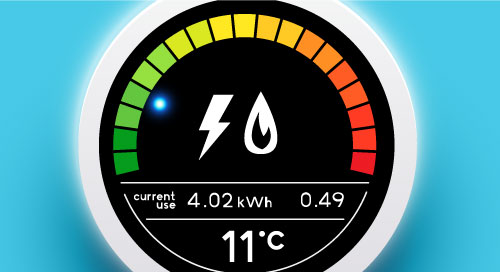From HVAC to Cold Case: IoT Powers Retail Energy Management

People flock to big box stores like Costco and Walmart to buy everything from ice cream to iPhones, and like other retailers, the superstores are always looking to ways to streamline operations and cut costs.
But when a store is the size of a city block, that’s no easy task. It takes a lot of work—and staff time—to keep HVAC systems, food court ovens, store lighting, and digital displays operating at maximum efficiency.
The hundreds of refrigeration and freezer cases add yet another layer of complexity. They need constant monitoring to meet government regulations but adjusting them manually can compromise food safety. What’s more, if a part breaks down, food sales and service come to a sudden halt—irritating customers and slashing profits.
Extending the Digital Transformation Trend in Retail
Inefficient management of energy systems stands out as an anomaly in the retail sector, which is increasingly adopting sophisticated digital solutions for other operations.
“Retailers have very mature technology for managing point-of-sale, inventory, and CRM, but they still rely heavily on manual work for back-end systems,” says Vincent Shao, sales manager at Novakon, a subsidiary of industrial computer manufacturer IBASE Technology.
A worldwide worker shortage and the subsequent rise in labor costs adds to the problem. “Retailers definitely don’t want to hire additional people to do the back-end facility tracking and monitoring,” Shao says.
Retailers have appealed to systems integrators (SIs) for years to find a better way to manage their refrigeration – and to lower costs for back-end systems like heating, air conditioning, and the electrical systems that power everything from lighting, to ovens, to toilets. But finding a workable IoT solution has proved surprisingly elusive.
#Retailers can view the status of #refrigeration equipment—as well as power consumption for all #connected appliancesand devices—on a single platform. @IBASE_Tech via @insightdottech
Traditionally, there have been two types of energy management systems on the market, Shao says. The first requires systems integrators to build an entire energy management software program from scratch—an effort too resource-intensive to be feasible. The alternative is to purchase an off-the-shelf building management system, such as those used by apartment buildings and office towers. But those systems don’t accommodate retailers’ needs and can’t be customized.
A New Platform for IoT Energy Management
After hearing complaints from SIs stymied by their inability to help retail customers manage their energy needs, IBASE and Novakon created a system designed specifically for retailers. The IBASE IoT Energy Management Platform monitors and manages freezers, refrigerators, air conditioning, and lighting—as well as systems like kiosk signs and food court appliances.
“Everything is connected to the Internet, and everything can be tracked, monitored, and controlled in real time,” Shao says.
That means busy staffers no longer must tend to refrigerators and freezers. Instead, the system tracks and records data from the sensors they contain, transmitting new information every minute.
Retailers can view the status of refrigeration equipment—as well as power consumption for all connected appliances and devices—on a single platform. And if something goes wrong with a piece of equipment, they receive an immediate alert, which is also sent to the servicing company so parts can be ordered right away.
In addition, the system automatically turns lights and HVAC on and off to sync with business hours, and retailers can tweak the settings to save even more energy—and money. Many utility companies offer discounts to business customers who keep power consumption beneath a certain threshold.
Opportunities for Retailers Small and Large
For large retailers, the energy and resource savings really add up. For example, at a retail chain with operations in China and Taiwan, each big box store contains 36 air conditioning units, 250 lighting devices, and 22 power meters. Before deploying the IBASE platform, stores had almost no knowledge of energy use or equipment status, in part because staffers had to walk the floor with notebooks, writing down appliance information every hour.
“Now the system works automatically, with no human interaction required,” Shao says, providing a wealth of ibase data that was impossible to gather before.
But automation is also valuable in smaller stores, where employees may have extra duties, such as receiving and delivering packages and preparing food, and are often stretched too thin to properly monitor equipment.
Tailoring the Software
Intel® processors enable the IBASE hardware 15 open-frame Panel PC to handle multiple systems with varying demands for computing power—and can be changed based on each customer’s different requirements. Integrators typically work with Novakon to customize its iFace software for a customer’s specific needs.
SIs give Novakon information about the customer’s floor plan and the brands and models of equipment to be connected, then Novakon develops a “first edition,” or demonstration model. Later, they can use iFace’s low code software to add more granular customizations.
“All the services and widgets are built in; an integrator just drags and drops them onto the screen to do the configuration,” Shao says. And after installation, retailers can make simple adjustments, like schedule changes, without assistance.
Expanding IoT Capabilities in the Retail Sector
By studying IBASE data about machine performance and energy use over time, SIs will eventually be able to develop predictive maintenance models, allowing retailers to find incipient problems and schedule repairs before they cause breakdowns. Novakon is also working to add refrigerated delivery trucks to the platform, enabling retailers to trace food safety from production to store shelves. The comprehensive platform could also be extended to grocery stores and restaurants.
“We have taken the first step—collecting all the data from legacy machines,” Shao says. “In the future, retailers can find more ways to put the information to good use.”
This article was edited by Georganne Benesch, Associate Content Director for insight.tech.